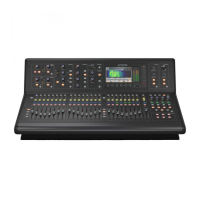Psychoacoustics:
The study of the perception of sound, that
is, how we listen, our psychological responses and the
physiological effects on the human nervous system.
Pschycoacoustic noise:
Noise that affects the physiology of the
listener.
Q
Quick access button:
Button for navigation/ selection of a
channel/bus/ processing area.
R
RAM:
Abbreviation for ‘Random access memory’.
Return:
Auxiliary return or aux return. An extra input used for
receiving a signal from the output of an internal or external
effect processor. See Bus.
Reverb:
An effect where the ambience of a physical space is
simulated. This is done by copying a signal and replaying at
regular intervals at ever decreasing levels. The intervals are
so close that each copy is not heard individually.
RMS:
Abbreviation for ‘root-mean-square’. The square root of the
mean of the sum of the squares. Commonly used as the effective
value of measuring a sine wave’s electrical power. A standard in
amplifier measurements. The effective average value of an AC
waveform.
RS:
Abbreviation for ‘right surround’. The right-hand rear
speaker in a 5.1 surround system.
S
s:
Symbol for ‘second’. A unit of time.
Scene:
In automation, a set of mix settings for a particular part
of a performance, for example, a play or song.
Sibilance:
Energy from a voice, centred around 7 kHz, and
caused by pronouncing ‘s’, ‘sh’ or ‘ch’ sounds.
Side chain:
A special circuit that diverts a proportion of the
main signal so that it can be processed, as required.
Compressors use the side chain to derive their control signals.
Signal flow:
The path of a signal from one place to another.
SIP™:
Abbreviation for ‘solo in place’.
SIS:
Abbreviation for ‘spatial imaging system’. Combines a central
loudspeaker cluster with a left-right system to form three discrete
sound channels.
Snapshot:
A captured group of mixer settings that reflect the
state of the mixer at a particular moment within a performance.
This snapshot can then be recalled at the required moment in
the performance/playback.
Solo:
During monitoring, the isolation of one signal by silencing
all other signals.
Source:
The patch connector from which a signal is patched. See
Patching.
SPL:
Abbreviation for ‘sound pressure level’. Given in decibels
(dB), SPL is an expression of loudness or volume.
Splash screens:
The GUI display during power up.
SRC:
Abbreviation for ‘sample rate converter’.
SSD:
Abbreviation for ‘solid-state disk’. Data storage device that
uses non- volatile memory to store data. Quicker than the
conventional hard disk and less susceptible to the failures
associated with hard disk drives.
Status indicator:
A device specifically designed to show the
condition of something. For example, an LED that shows whether a
pushbutton is on or off, or a meter showing the level of a signal.
Stereo:
Two separate channels, left and right, used to give the listener the
perception of where the noise is coming from. Usually used with music to give a
fuller, more natural sound.
Stereo image:
The perception of the different sound sources coming from far
left, far right or anywhere in between.

